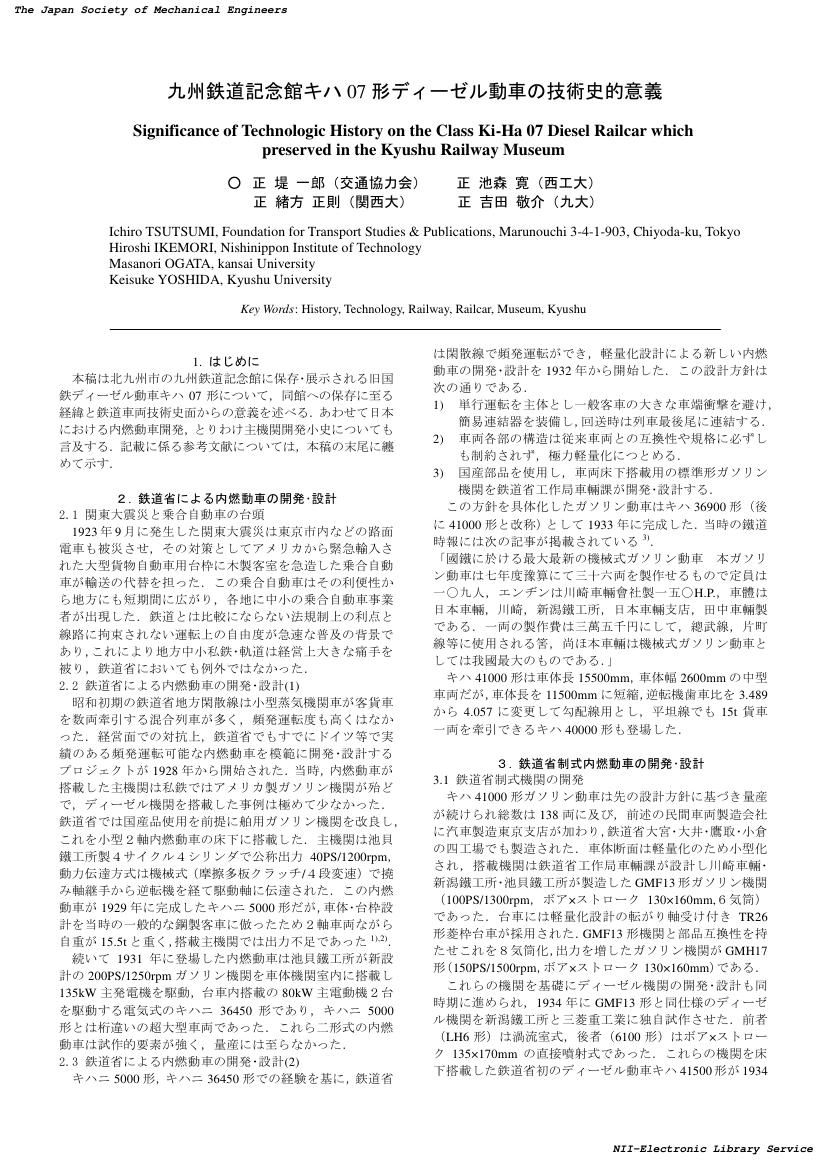20 0 0 0 OA 明治期の官設鉄道工場における木製客車の製造と日本人技術者の養成
- 著者
- 堤 一郎
- 出版者
- 一般社団法人 日本機械学会
- 雑誌
- 日本機械学会論文集 C編 (ISSN:03875024)
- 巻号頁・発行日
- vol.74, no.746, pp.2387-2395, 2008-10-25 (Released:2011-03-04)
- 参考文献数
- 17
Wooden carriage manufacture of Japanese Imperial Government Railway (J. I. G. R.) Works and Japanese young railway engineer cultivation in the Meiji period are described. In the start of J. I. G. R.'s transport business, 143 rolling stocks were imported from the U. K., and English railway engineers were employed. They cultivated Japanese young trainees through the construction of wooden carriages by themselves on the job training. A drawing of Adams bogie track with Munsell wheels, brief personal record of four English railway engineers and three Japanese young engineers were explained. Mechanical Engineering Heritage of four wooden carriages preserved in Japan are introduced, too.
- 著者
- 堤 一郎
- 出版者
- 職業能力開発総合大学校能力開発研究センター
- 雑誌
- 職業能力開発研究 (ISSN:09199594)
- 巻号頁・発行日
- vol.29, pp.49-53, 2011
- 著者
- 堤 一郎 池森 寛
- 出版者
- 一般社団法人日本機械学会
- 雑誌
- 日本機械学会九州支部講演論文集
- 巻号頁・発行日
- vol.2010, no.63, pp.11-12, 2010-03-15
In this report, a short history and outline of wooden four wheel third class coach built by the Kokura works of Kyushu Railway Company in Fukuoka Prefecture will be explained. This wooden coach was constructed in 1897 and German-made; Van der Zypen & Charlier, same type coach became an example of it. Domestic-made this coach has been preserved at the Kyushu Railway Museum, Kitakyushu-city from 2004. Contents of this report are as follows. 1) A short history and outline of this domestic-made wooden four wheel third class coach. 2) Results of field study and relational analysis on the preserved two wooden four wheel coaches. 3) Significance on the history of technology of this wooden coach and conclusion of this report.
- 著者
- 堤 一郎
- 出版者
- 職業能力開発総合大学校能力開発研究センター
- 雑誌
- 職業能力開発研究 (ISSN:09199594)
- 巻号頁・発行日
- vol.27, pp.21-35, 2009
2 0 0 0 OA 改軌論争 : 国鉄の軌間は狭軌か広軌か(<特集>科学と工学における論争)
- 著者
- 堤 一郎
- 出版者
- 一般社団法人 日本機械学会
- 雑誌
- 日本機械学会誌 (ISSN:24242675)
- 巻号頁・発行日
- vol.113, no.1097, pp.247-252, 2010-04-05 (Released:2017-06-21)
- 参考文献数
- 21
- 著者
- 大河内 信夫 板倉 嘉哉 堤 一郎 白井 靖幸
- 出版者
- 一般社団法人 日本機械学会
- 雑誌
- 日本機械学会関東支部総会講演会講演論文集 2007.13 (ISSN:24242691)
- 巻号頁・発行日
- pp.171-172, 2007-03-15 (Released:2017-06-19)
The authors studied Fujiwara's water-wheels for irrigation which were built at Kazusa region in Chiba prefecture. They surveyed literature on bucket chain conveyor system for water in the Edo period. There were 3 materials concerned with Fujiwara's water-wheel. The authors restored Fujiwara's water-wheel bucket which was drawn on the Report of Archaeological Investigation carried out the Fujiwara-Type scoop wheel, No. 1 and 2 in Yoro, Ichihara city, Chiba prefecture. They compared data of Fujiwara's water-wheel bucket restored with data of literature for Fujiwara's water-wheel. Fujiwara's water-wheel power was calculated from data of the bucket restored.
1 0 0 0 OA 第22回国際科学史会議での日本からの報告(続)
1 0 0 0 OA 日本における初期の鉱山用電気機関車の製造と日本人技術者
- 著者
- 堤 一郎
- 出版者
- 一般社団法人 日本機械学会
- 雑誌
- 日本機械学会論文集 C編 (ISSN:03875024)
- 巻号頁・発行日
- vol.74, no.746, pp.2396-2402, 2008-10-25 (Released:2011-03-04)
- 参考文献数
- 30
The first domestically-built mine type electric locomotive is said to be the locomotive used at the Ashio Copper Mine in Tochigi Prefecture, Kanto District. Wheel arrangement of this electric locomotive was 0-4-0, and built in 1893 by Ashio Copper Mine Works. Mechanical and electric engineer relation to this locomotive building was Mr. Kumazo Miyahara who graduated at Telegram Vocational Training School of Ministry of Communications. In addition to this locomotive, other two examples of mine type electric locomotive building are introduced. In the final section of this paper, significance of domestic building of mine type electric locomotive examples are discussed from the perspective of history of technology and mechanical engineering heritage.
1 0 0 0 OA 612 九州鉄道記念館キハ07形ディーゼル動車の技術史的意義
- 著者
- 堤 一郎 池森 寛 緒方 正則 吉田 敬介
- 出版者
- 一般社団法人 日本機械学会
- 雑誌
- 日本機械学会九州支部講演論文集 2014.67 (ISSN:24242780)
- 巻号頁・発行日
- pp._612-1_-_612-2_, 2014 (Released:2017-06-19)
1 0 0 0 愛知県立豊橋工業高等学校の「からくり」時計塔
- 著者
- 堤 一郎
- 出版者
- 一般社団法人 日本時計学会
- 雑誌
- 日本時計学会誌 (ISSN:00290416)
- 巻号頁・発行日
- vol.153, pp.91-95, 1995
- 著者
- 堤 一郎 林 邦夫 落合 大典 遠藤 秀明
- 出版者
- 公益社団法人日本工学教育協会
- 雑誌
- 工学・工業教育研究講演会講演論文集
- 巻号頁・発行日
- vol.10, pp.271-272, 1998-07-30
1 0 0 0 IR 茨城県内の煉瓦造鉄道施設に関する追跡調査 -停車場内煉瓦造危険品庫について-
- 著者
- 堤 一郎 安田 健一 TSUTSUMI Ichiro YASUDA Kenichi
- 雑誌
- 茨城大学教育学部紀要(教育科学)
- 巻号頁・発行日
- vol.65, pp.173-185, 2016-03-28
- 著者
- 堤 一郎
- 出版者
- 一般社団法人日本機械学会
- 雑誌
- 日本機械学會論文集. C編 (ISSN:03875024)
- 巻号頁・発行日
- vol.74, no.746, pp.2396-2402, 2008-10-25
The first domestically-built mine type electric locomotive is said to be the locomotive used at the Ashio Copper Mine in Tochigi Prefecture, Kanto District. Wheel arrangement of this electric locomotive was 0-4-0, and built in 1893 by Ashio Copper Mine Works. Mechanical and electric engineer relation to this locomotive building was Mr. Kumazo Miyahara who graduated at Telegram Vocational Training School of Ministry of Communications. In addition to this locomotive, other two examples of mine type electric locomotive building are introduced. In the final section of this paper, significance of domestic building of mine type electric locomotive examples are discussed from the perspective of history of technology and mechanical engineering heritage.
- 著者
- 堤 一郎
- 出版者
- 一般社団法人日本機械学会
- 雑誌
- 日本機械学會誌 (ISSN:00214728)
- 巻号頁・発行日
- vol.113, no.1097, pp.247-252, 2010-04-05


